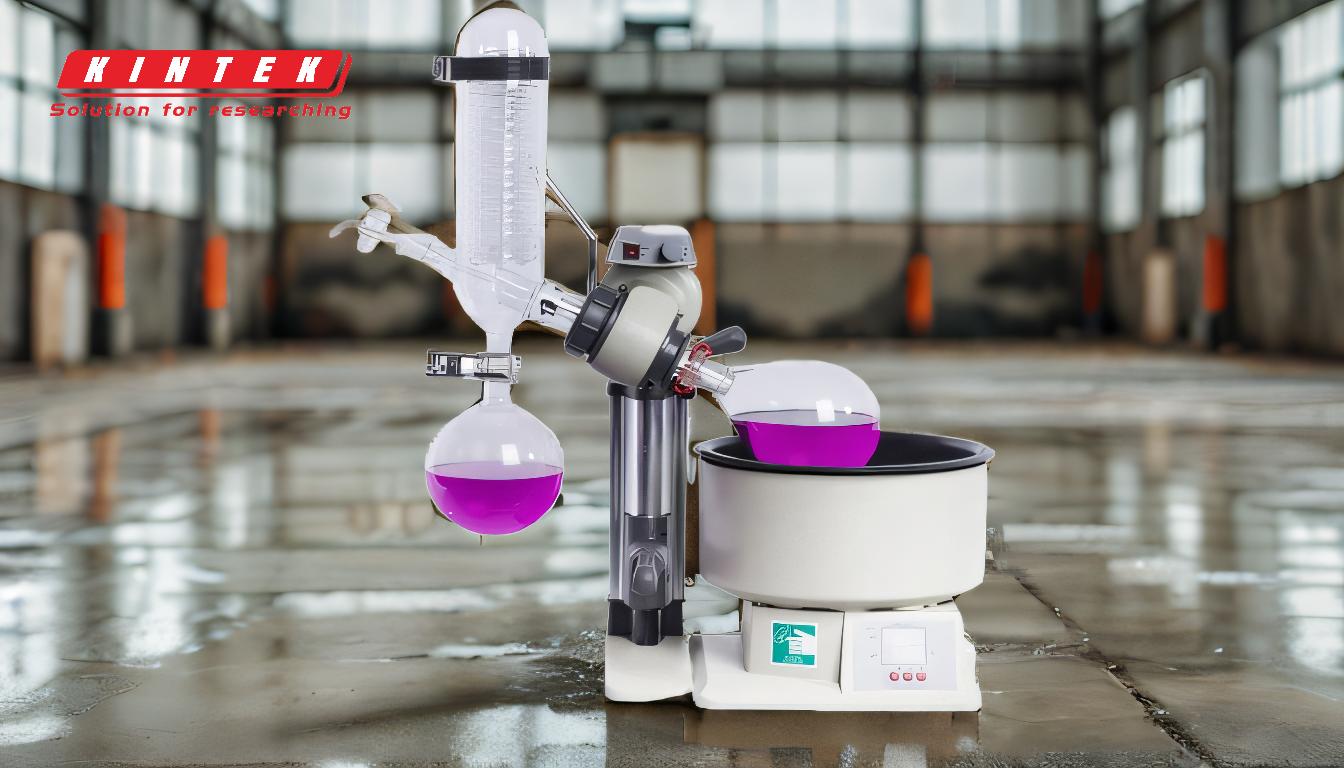A rotary evaporator, often referred to as a rotavap or rotovap, is a specialized laboratory instrument designed for the efficient and gentle removal of solvents from samples through evaporation under reduced pressure. It is widely used in various industries, including pharmaceuticals, chemicals, and food production, for tasks such as solvent recovery, concentration, and purification. The device operates by lowering the pressure inside the system, which reduces the boiling point of the solvent, allowing it to evaporate at lower temperatures. This process minimizes the risk of thermal decomposition and ensures the integrity of heat-sensitive compounds. The rotary evaporator consists of key components like a rotating flask, a heated water bath, a condenser, and a vacuum system, all working together to maximize evaporation efficiency and solvent recovery.
Key Points Explained:

-
Purpose of a Rotary Evaporator:
- A rotary evaporator is primarily used for solvent recovery, which involves separating and reclaiming solvents from mixtures. This is particularly important in industries where solvents are expensive or hazardous, and their reuse is economically or environmentally beneficial.
- It is also used for concentration, crystallization, drying, and separation of compounds, making it a versatile tool in laboratory and industrial settings.
-
How It Works:
- Reduced Pressure: The rotary evaporator operates under reduced pressure, which lowers the boiling point of the solvent. This allows solvents to evaporate at much lower temperatures than their standard boiling points, reducing the risk of thermal degradation.
- Rotation: The sample is placed in a round-bottomed flask, which rotates at a controlled speed. This rotation creates a thin film of the sample on the inner walls of the flask, increasing the surface area for evaporation and speeding up the process.
- Heated Water Bath: The flask is immersed in a heated water bath, which provides uniform heating to the sample. The temperature of the bath is carefully controlled to ensure efficient evaporation without overheating.
- Condensation: The evaporated solvent travels through a condenser, where it is cooled and re-condensed into a liquid. The condensed solvent is then collected in a separate flask, while the concentrated sample remains in the original flask.
-
Key Components:
- Evaporation Flask: A round-bottomed flask that holds the sample and rotates to create a thin film for efficient evaporation.
- Water Bath: Provides controlled heating to the flask, ensuring uniform temperature distribution.
- Condenser: Cools the solvent vapor, converting it back into a liquid for collection.
- Vacuum System: Reduces the pressure inside the system, enabling lower-temperature evaporation.
- Receiving Flask: Collects the condensed solvent after it passes through the condenser.
-
Applications:
- Pharmaceutical Industry: Used for purifying and concentrating active pharmaceutical ingredients (APIs) and recovering solvents from reaction mixtures.
- Chemical Industry: Essential for solvent recovery, product purification, and separation of chemical compounds.
- Food Industry: Utilized for concentrating flavors, extracting essential oils, and removing solvents from food products.
- Research Laboratories: Commonly used in organic chemistry labs for solvent removal and sample preparation.
-
Advantages:
- Efficiency: The rotary evaporator allows for rapid and efficient solvent removal, even for large volumes (up to 3 liters in some models).
- Gentle Process: By operating at reduced pressure and lower temperatures, it minimizes the risk of thermal decomposition, making it ideal for heat-sensitive compounds.
- Versatility: Suitable for a wide range of solvents and applications, from small-scale experiments to pilot production.
- Cost-Effective: Enables solvent recovery, reducing waste and lowering operational costs.
-
Considerations for Purchasers:
- Capacity: Choose a model with a flask size that matches your typical sample volumes.
- Temperature Control: Ensure the water bath has precise temperature control for optimal performance.
- Vacuum System: Look for a robust vacuum pump and pressure control system to handle a variety of solvents and pressures.
- Material Compatibility: Verify that the components are made from materials resistant to the solvents and chemicals you will be using.
- Ease of Use: Consider features like automated rotation speed control, easy-to-clean components, and user-friendly interfaces.
By understanding the principles, components, and applications of a rotary evaporator, purchasers can make informed decisions to select the right equipment for their specific needs, ensuring efficient and reliable solvent recovery and sample processing.
Summary Table:
| Aspect | Details |
|---|---|
| Purpose | Solvent recovery, concentration, crystallization, drying, and separation. |
| How It Works | Reduced pressure lowers boiling points; rotation increases evaporation. |
| Key Components | Evaporation flask, water bath, condenser, vacuum system, receiving flask. |
| Applications | Pharmaceuticals, chemicals, food production, research labs. |
| Advantages | Efficient, gentle on heat-sensitive compounds, versatile, cost-effective. |
| Purchase Considerations | Capacity, temperature control, vacuum system, material compatibility. |
Optimize your lab processes with a rotary evaporator—contact us today to find the perfect solution!










